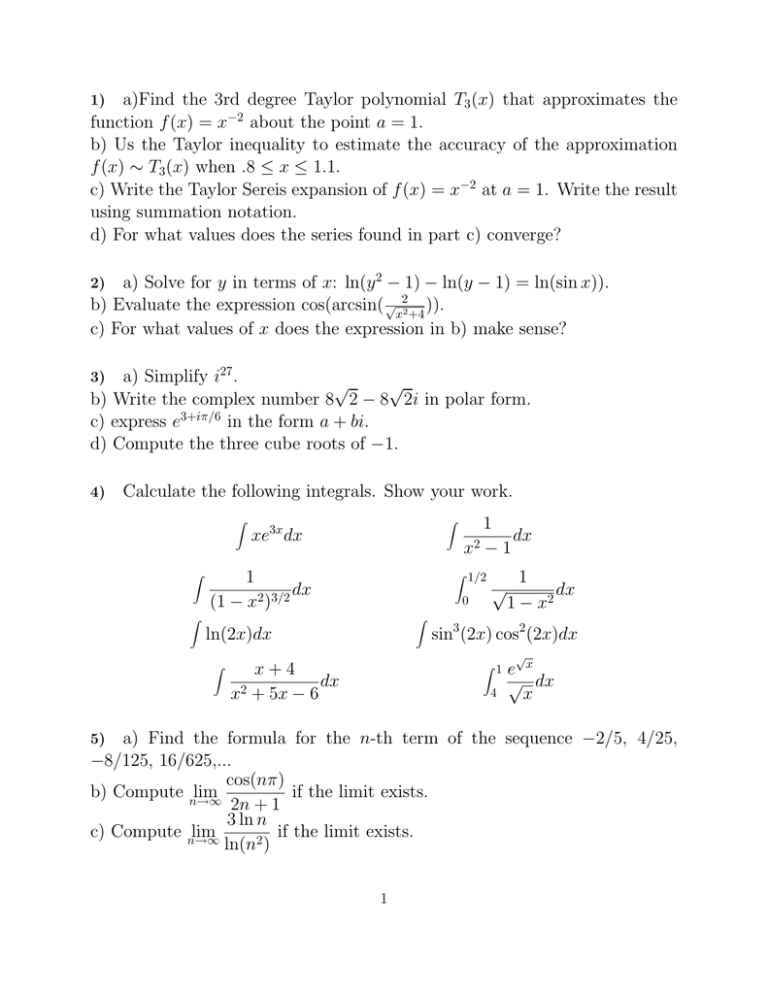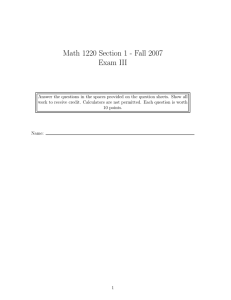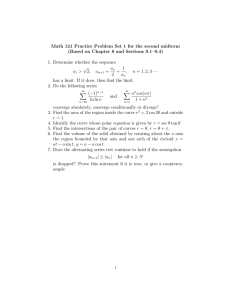a)Find the 3rd degree Taylor polynomial T (x) that approximates the
advertisement

a)Find the 3rd degree Taylor polynomial T3 (x) that approximates the function f (x) = x−2 about the point a = 1. b) Us the Taylor inequality to estimate the accuracy of the approximation f (x) ∼ T3 (x) when .8 ≤ x ≤ 1.1. c) Write the Taylor Sereis expansion of f (x) = x−2 at a = 1. Write the result using summation notation. d) For what values does the series found in part c) converge? 1) a) Solve for y in terms of x: ln(y 2 − 1) − ln(y − 1) = ln(sin x)). b) Evaluate the expression cos(arcsin( √x22 +4 )). c) For what values of x does the expression in b) make sense? 2) a) Simplify i27 . √ √ b) Write the complex number 8 2 − 8 2i in polar form. c) express e3+iπ/6 in the form a + bi. d) Compute the three cube roots of −1. 3) 4) Calculate the following integrals. Show your work. Z Z Z Z xe3x dx 1 dx (1 − x2 )3/2 1 dx x2 − 1 Z 1/2 0 Z ln(2x)dx √ 1 dx 1 − x2 sin3 (2x) cos2 (2x)dx √ Z x+4 dx x2 + 5x − 6 Z 1 4 e x √ dx x a) Find the formula for the n-th term of the sequence −2/5, 4/25, −8/125, 16/625,... cos(nπ) b) Compute n→∞ lim if the limit exists. 2n + 1 3 ln n c) Compute n→∞ lim if the limit exists. ln(n2 ) 5) 1 Determine whether the series is absolutely convergent, conditionally convergent or divergent. If it is a gemoetric series find the limit. Justify your answer. 2n ∞ ∞ n2 + 5n + 1 X X n2 (−1) n 5 5 − 2n2 n=1 n=1 ∞ 2n + 1 ∞ X X eπ π −n en n 3 n=1 n=1 6) (−1)n−1 √ n+1 n=1 3n3 + 2n2 + 3n4 5 2 n=1 3n + 3n − 3n ∞ X ∞ X a) Sketch the curve of the parametric equation x = t2 − 2t, y = t + 1, −1 ≤ t ≤ 3 and indicate with arrows the direction. b) Find points on the curve where the tangent is horizontal or vertical. c) Find the tangent to the curve at point (0, 3). d) Calculate the length of the curve. 7) Sketch the region that lies inside the curve r = 1 − cos θ and outside the curve r = 3/2. Find the area. 8) 9) t). If dy = 2yt and y(0) = 50, find y as a function of t (assume y > 0 for all dt Let f (x) = 2x + 12 cos(2x) for 0 ≤ x ≤ 4π. a) Determine whether f is invertible. b) Give domain and range for f and f −1 . df −1 c) Calculate (x) 1 . (Note that f (π) = x= 2 +2π dx 10) 11) Calculate ii . 2 1 2 + 2π.)





